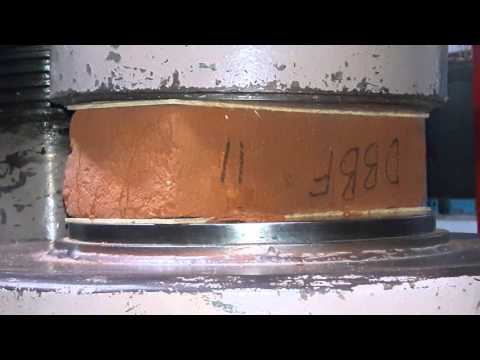Compressive Strength of Red Clay Bricks - As per IS Code provisions
Compressive strength of clay bricks is carried out as per
IS 3495 Part 1 2019.pdf 456.53 KB
.
Method of testing the bricks involves the following sequence:
1. Immersion of Bricks
Immerse the brick specimens in water at a temperature of 27 ± 2°C for 24 h.
Remove the specimens and drain out any surplus moisture.
2. Grinding the surface
Remove unevenness observed in the bed faces to provide two smooth and parallel faces by grinding.
However, If the grinding process is expected to significantly alter the contact area of the tested faces then the capping shall be done using cement mortar to achieve two smooth and parallel faces.
3. Filling of Frog with Mortar
Use a cement/sand mortar for capping and filling the frog (where provided) and all voids in the bed faces
Store under the damp jute bags for 24 h followed by immersion in clean water for 3 days at a temperature of 27 ± 2°C. Remove, and wipe out any traces of moisture.
4. Procedure for Testing
Place the specimens with flat faces horizontal, and mortar filled face facing upwards between two 3-ply plywood sheets each of 3 mm thickness and carefully centered between plates of the testing machine.
Apply load axially at a uniform rate of 7 ± 1 N/mm2/min till failure occurs and note the maximum load at failure.
5. Compressive Strength Calculation
Failure/ Pass Criteria for Compressive Strength
A lot of brick shall be considered to be defective / failed if any of the following conditions are met:
Average compressive strength of samples as Sampling Criteria should not be less than class strength of the bricks.
Any individual brick strength comes out to be less than 15% of Class Strength
For example, a brick lot may be examined for approval or denial as per follows:
For Bricks of Class-10, the average compressive strength of say a sample size of 10 bricks for a lot size of 30000 bricks shall not be below 10 N/mm²
Of the 10 bricks tested above, the compressive strength of none of those bricks should fall below 15% of class strength of 10 N/mm² i.e. 8.5 N/mm²
Originally the criteria of failure was 20% as per IS 5454 Clause 5.2.1.1, however, as per the amendment issued in 2008 for IS 1077 the criteria for failure has been made more stringent by reducing it from 20% to 15%.
---- The End ----
Please let me know if you liked the article and suggest improvements if any.
Have a wonderful day,
Kushal @ Civil Black Box

